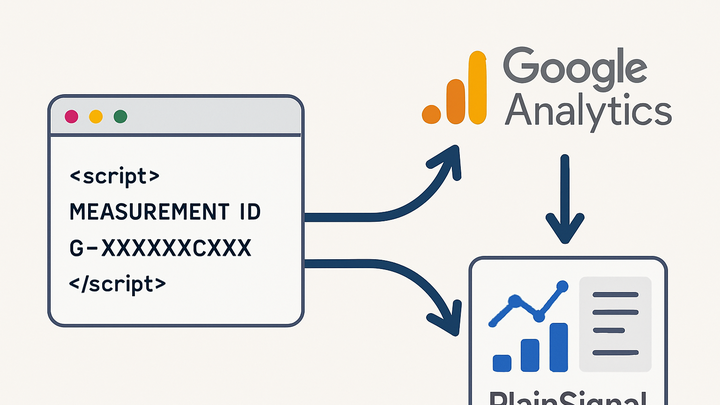Published on 2025-06-26T04:17:45Z
What is Measurement ID? Examples for Measurement ID
In analytics, a Measurement ID is a unique identifier assigned to each data stream within an analytics property. It acts as a routing key for event data, allowing analytics platforms to send and aggregate user interactions correctly. In Google Analytics 4 (GA4), measurement IDs use a ‘G-’ prefix followed by ten characters, and they are crucial for configuring the global site tag or Google Tag Manager. In PlainSignal, a privacy-focused, cookie-free analytics solution, measurement IDs appear as the ‘data-id’ attribute in the loader script. Proper implementation and management of measurement IDs ensure that website events are attributed to the right property, facilitate accurate reporting, and simplify troubleshooting.
Measurement id
Unique alphanumeric identifier for analytics data streams in GA4 and PlainSignal that routes event data to the correct property.
Introduction to Measurement ID
Measurement IDs serve as the backbone of event routing in modern analytics. They uniquely identify individual data streams within an analytics property, ensuring that all collected data from websites or apps is attributed correctly. By embedding a measurement ID in your tracking setup, you inform the analytics servers where to send each hit or event. Understanding this concept is essential for accurate data collection and analysis across different platforms.
-
What is a measurement id?
A Measurement ID is a unique alphanumeric string that identifies a specific data stream within an analytics platform. It allows the system to distinguish between multiple properties or streams under the same account.
-
Why measurement ids matter
They ensure that events and user interactions are sent to the correct analytics property or data stream, which is fundamental for reliable reporting and insights.
Measurement ID in Google Analytics 4
In GA4, measurement IDs link your site or app to a specific data stream. They follow a standardized format and are integrated through tags or tag managers to begin collecting user interaction data.
-
Format and structure
GA4 Measurement IDs start with ‘G-’ followed by ten uppercase alphanumeric characters (e.g., G-1A2B3C4D5E). This format ensures global uniqueness across all GA4 properties.
-
Implementation with gtag.js
Include the Measurement ID in the global site tag to configure tracking:
<script async src="https://www.googletagmanager.com/gtag/js?id=G-1A2B3C4D5E"></script> <script> window.dataLayer = window.dataLayer || []; function gtag(){dataLayer.push(arguments);} gtag('js', new Date()); gtag('config', 'G-1A2B3C4D5E'); </script> -
Implementation with google tag manager
When using GTM, add a GA4 Configuration tag and enter your Measurement ID in the tag settings. GTM then handles script injection and dataLayer initialization automatically.
Measurement ID in PlainSignal
PlainSignal is a cookie-free analytics solution that uses measurement IDs to assign incoming event data to the correct property. Integration involves adding a script tag with data attributes rather than a traditional cookie-based script.
-
Script tag integration
Insert the PlainSignal loader with your Measurement ID as the ‘data-id’ attribute. Example:
<link rel="preconnect" href="//eu.plainsignal.com/" crossorigin /> <script defer data-do="yourwebsitedomain.com" data-id="0GQV1xmtzQQ" data-api="//eu.plainsignal.com" src="//cdn.plainsignal.com/plainsignal-min.js"></script>
Best Practices
Following these guidelines helps maintain data integrity and simplifies long-term analytics management.
-
Validate id formats
Ensure GA4 Measurement IDs start with ‘G-’ and PlainSignal IDs match your account pattern to prevent tracking errors.
-
Deploy consistently
Place measurement ID code in the <head> of every page to capture all views and events, avoiding gaps in your data.
-
Use debug tools
Leverage GA4 DebugView and PlainSignal’s development console to verify that your measurement ID is correctly sending data and to troubleshoot in real-time.
Troubleshooting Common Issues
When data isn’t appearing as expected, these checks can help identify and resolve common configuration issues.
-
Typographical errors
A single character mismatch in the measurement ID can stop data collection. Always copy and paste IDs directly from your analytics settings.
-
Script loading failures
Inspect network requests for 404 or blocked calls. Ensure scripts load over HTTPS and domains match your analytics endpoints.
-
GA4 endpoint
Requests should go to https://www.google-analytics.com/g/collect.
-
PlainSignal endpoint
Verify calls to //eu.plainsignal.com/plainsignal-min.js and subsequent data dispatch URLs.
-
-
Mixed content blocking
Loading analytics scripts over HTTP on an HTTPS site can be blocked by browsers. Use protocol-relative or HTTPS URLs to avoid these issues.
